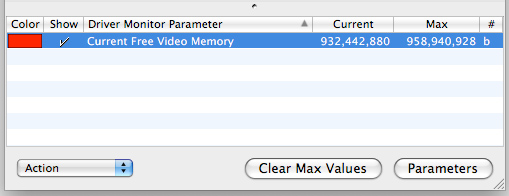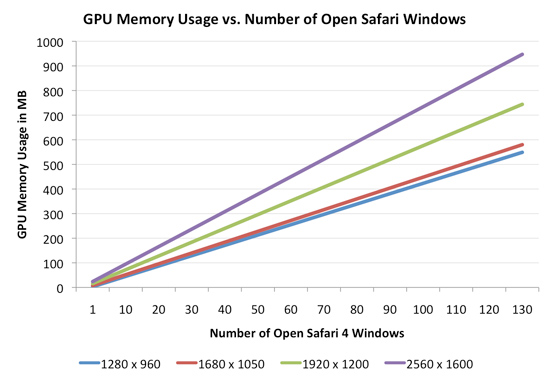EVGA's GeForce GTX 285 Mac Edition: The Best for OS X?
by Anand Lal Shimpi on July 17, 2009 7:00 PM EST- Posted in
- GPUs
Performance Testing: Does Video Memory Size Matter?
This section is the most difficult one to write, the problem is that there aren’t that many good performance tests for a high end GPU under OS X. It also happens to be a big part of the reason Apple can get away with shipping integrated graphics in the majority of its machines and a low end add in card in its Mac Pro. Honestly, one of the biggest uses for a new graphics card under OS X is having additional video memory.
The contents of each window and the windows themselves are drawn by the GPU and stored in video memory. Previous versions of OS X either drew windows in system memory and then composited all of them in video memory, or did everything in system memory and just outputted the final scene to the video card. Ever since OS X 10.4, the entire drawing and display process happens on the GPU and in video memory. Ars Technica’s John Siracusa has an excellent explanation of the whole process.
Each window gets treated as a 2D OpenGL surface and all of the character and image rendering, blending and display happens on the GPU. The GPU is much faster at all of this than the CPU so it made sense. The result is much lower CPU and system memory usage. What it also means is that the amount of video memory you have matters.
If you run out of video memory, the GPU has to swap data in and out of system RAM. The trip to system memory is much higher latency than just grabbing windows from video memory, and thus we see performance suffer. Faster memory busses and PCIe 2.0 both help minimize the impact, but it’s there nonetheless.
The issue is never about how many windows you can have open, but how smoothly effects like Dashboard and Exposé run. Those depend on having enough video memory to store/manipulate all open windows.
I ran some tests to figure out exactly how much video memory was enough for a single display. I started with a blank desktop and measured available video memory. On a 512MB card, at 2560 x 1600, you end up with 488MB of free video memory in OS X 10.5.7.
Depending on the contents of the windows you open, their memory requirements will differ. I found that a full height Safari 4 window showing the AnandTech home page was pretty stressful from a memory footprint standpoint. A single Safari 4 window required 7MB of video memory at 2560 x 1600. Finder windows are much cheaper, some application windows are much more expensive (more on this later).

With a single window requiring 7MB, 10 requires about 70MB. Now things don’t always scale linearly and there’s additional overhead for dealing with more windows. At 10 windows that overhead appears to be around 1MB. While a single Safari 4 window needs 7MB at 2560 x 1600, ten will need around 71MB; twenty windows will need 144MB.
Lower resolutions require less video memory. At 1680 x 1050 the cost per 10 windows drops from 71MB to 44MB.
I extrapolated the data out to 130 Safari 4 windows and presented the video memory requirements, dependent on resolution in the graph below:

If you have a 30” monitor running at its native resolution (2560 x 1600), a 512MB video card will get you just under 70 windows.
Note that not all applications play nicely. Take Photoshop CS4 for example. One of its major features is the ability to enable OpenGL acceleration within the application. With each image being OpenGL accelerated you get benefits like being able to zoom and rotate smoothly, the downside is that each image you open in Photoshop now eats up even more video memory.
Under OS X each 12MP image from my digital camera that I open in Photoshop eats up around 56MB of video memory (at 2560 x 1600)! To make matters worse, OS X won’t reclaim all of the memory even if you close all of the images in Photoshop. You need to exit Photoshop to get all of your video memory back.
While it would take 70 normal windows to max out the 512MB of video memory on a GeForce GT 120 at 2560 x 1600, it would take less than nine 12MP images open in Photoshop to do the same. And once again, you don’t get that memory back when you close your images - only after you exit Photoshop. Most other windows in OS X will give you your GPU memory back as soon as you close the window.
If you find yourself doing a lot of work in Photoshop, you’ll want to either limit the number of images you have open at once or disable OpenGL acceleration. And by all means, quit the app once you’re done editing. Of course you could always move to a graphics card with more memory...










48 Comments
View All Comments
SiliconDoc - Saturday, July 18, 2009 - link
Yeah... boy a GTX285 seems pretty weak.(good lord!)
psonice - Saturday, July 18, 2009 - link
Well, a radeon 2600 is very weak compared to a gf8800. Yet it kills it in core image tasks (probably bad nvidia drivers, seeing as core image is based on GLSL, and the 8800 is way faster for that).My advice for people running CI heavy apps has been "avoid nvidia" for the last year or two, I'd like to know if that should change :)
Lanska - Saturday, July 18, 2009 - link
On MacOSX there isn't too enough games, but World of Warcraft from Blizzard is availaible. So you can test GTX 285 as a game accelerator card for Mac. I think many Mac gamers want to buy it as a game card, but not to display more windows in Photoshop or similar. After all you can even compare perfomance of World of Warcraft in Mac and in Windows on the same MacPro system (in Windows for more competition truth you can also use OpenGL mode instead of DirectX, as Mac version is OpenGL only).Game have testing command /timetest to benchmark system.
World of Warcraft client for both systems can be freely downloaded from Blizzard, trial accounts are also availaible. So you willn't pay any charge for testing, but this review will be more interesting, without games game card review not so nice :)
sprockkets - Tuesday, July 21, 2009 - link
You think WoW needs a GTX anything?ipay - Saturday, July 18, 2009 - link
It always sends me into fits of laughter when Anand acts surprised at the absurd price premiums on Apple products - as if Apple's strategy from their inception has been anything else than putting shit in a box and selling it as gold to gullible idiots with lots of money.I also got some kicks from reading the description of how to install the video card (something that any self-respecting PC owner can do in their sleep), as well as the fact that the Mac motherboard uses an Intel chipset of some sort.
Keep the lulz coming Anand, I really appreciate it!
sprockkets - Tuesday, July 21, 2009 - link
Laughter?More like his credibility.
Stuff like he still hasn't done any more research into why a MacBook "Pro" has better battery life under OSX than Windows, or why we should spend $2k more on a Mac Pro just to add a video card that can work with a $100 motherboard. I'm sure the average Mac user spends $2400 minimum on a machine for OSX, only to have to dual boot anyhow Windows to play Crysis, adding another $100 to the price, minimum.
"The other change is firmware. In order to get your PC video card to work under OS X it needs firmware with a few EFI hooks in it. It’s not a huge change, but for whatever reason the PC specific cards don’t have it."
Yeah, might have something to do with the fact that EFI sucks and PCs are better off without that crap. And even if EFI becomes standard in "PCs", Apple will just change the way OSX works to again kill it from working on any hardware.
rpmurray - Tuesday, July 21, 2009 - link
I can't help rolling on the floor when some dipwad blames Apple for the high prices of third-party add-ons. Especially when that same company sells it cheaper for the PC, which just goes to show you who's gouging whom.afkrotch - Friday, August 28, 2009 - link
Actually, it all boils down to being Apple's fault. They make a platform that they locked down a ridiculous amount. They then charge a premium for the trash and this causes elitist bitches to buy it, while no one else cares.Because there is such a small platform of users, companies have to charge a markup for having to make a product for a minimal amount of users.
Personally, Nvidia and AMD should just let Apple rot. Let S3 make their graphics cards.
sprockkets - Tuesday, July 21, 2009 - link
If you are used to buying Macs with pointless markups you are used to buying Mac accessories with pointless markups.Dainas - Saturday, July 18, 2009 - link
Anything that says apple on it is soo overpriced that there are many many forums dedicated to finding or making pc stuff that doesn't say apple on it work. The evga gtx 285 mac might actually sell boxed as they are only slightly insulting.